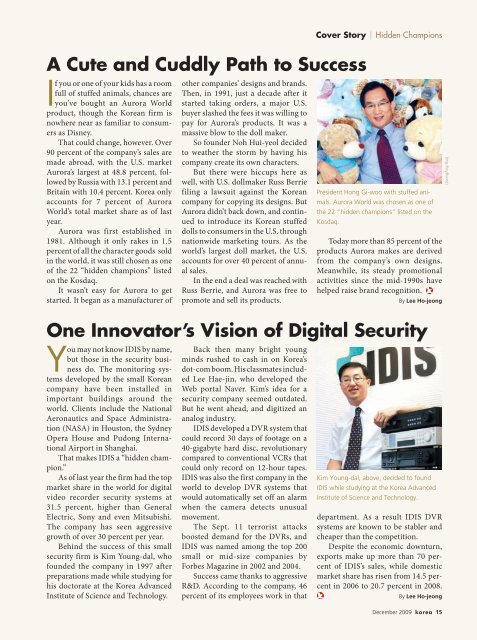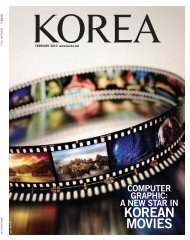2005-2162
12 Innovative Success Stories - Korea.net
12 Innovative Success Stories - Korea.net
- No tags were found...
You also want an ePaper? Increase the reach of your titles
YUMPU automatically turns print PDFs into web optimized ePapers that Google loves.
Cover Story | Hidden Champions<br />
A Cute and Cuddly Path to Success<br />
If you or one of your kids has a room<br />
full of stuffed animals, chances are<br />
you’ve bought an Aurora World<br />
product, though the Korean firm is<br />
nowhere near as familiar to consumers<br />
as Disney.<br />
That could change, however. Over<br />
90 percent of the company’s sales are<br />
made abroad, with the U.S. market<br />
Aurora’s largest at 48.8 percent, followed<br />
by Russia with 13.1 percent and<br />
Britain with 10.4 percent. Korea only<br />
accounts for 7 percent of Aurora<br />
World’s total market share as of last<br />
year.<br />
Aurora was first established in<br />
1981. Although it only rakes in 1.5<br />
percent of all the character goods sold<br />
in the world, it was still chosen as one<br />
of the 22 “hidden champions” listed<br />
on the Kosdaq.<br />
It wasn’t easy for Aurora to get<br />
started. It began as a manufacturer of<br />
other companies’ designs and brands.<br />
Then, in 1991, just a decade after it<br />
started taking orders, a major U.S.<br />
buyer slashed the fees it was willing to<br />
pay for Aurora’s products. It was a<br />
massive blow to the doll maker.<br />
So founder Noh Hui-yeol decided<br />
to weather the storm by having his<br />
company create its own characters.<br />
But there were hiccups here as<br />
well, with U.S. dollmaker Russ Berrie<br />
filing a lawsuit against the Korean<br />
company for copying its designs. But<br />
Aurora didn’t back down, and continued<br />
to introduce its Korean stuffed<br />
dolls to consumers in the U.S. through<br />
nationwide marketing tours. As the<br />
world’s largest doll market, the U.S.<br />
accounts for over 40 percent of annual<br />
sales.<br />
In the end a deal was reached with<br />
Russ Berrie, and Aurora was free to<br />
promote and sell its products.<br />
President Hong Gi-woo with stuffed animals.<br />
Aurora World was chosen as one of<br />
the 22 “hidden champions” listed on the<br />
Kosdaq.<br />
Today more than 85 percent of the<br />
products Aurora makes are derived<br />
from the company’s own designs.<br />
Meanwhile, its steady promotional<br />
activities since the mid-1990s have<br />
helped raise brand recognition. <br />
<br />
By Lee Ho-jeong<br />
[JoongAng Ilbo]<br />
One Innovator’s Vision of Digital Security<br />
You may not know IDIS by name,<br />
but those in the security business<br />
do. The monitoring systems<br />
developed by the small Korean<br />
company have been installed in<br />
important buildings around the<br />
world. Clients include the National<br />
Aeronautics and Space Administration<br />
(NASA) in Houston, the Sydney<br />
Opera House and Pudong International<br />
Airport in Shanghai.<br />
That makes IDIS a “hidden champion.”<br />
As of last year the firm had the top<br />
market share in the world for digital<br />
video recorder security systems at<br />
31.5 percent, higher than General<br />
Electric, Sony and even Mitsubishi.<br />
The company has seen aggressive<br />
growth of over 30 percent per year.<br />
Behind the success of this small<br />
security firm is Kim Young-dal, who<br />
founded the company in 1997 after<br />
preparations made while studying for<br />
his doctorate at the Korea Advanced<br />
Institute of Science and Technology.<br />
Back then many bright young<br />
minds rushed to cash in on Korea’s<br />
dot-com boom. His classmates included<br />
Lee Hae-jin, who developed the<br />
Web portal Naver. Kim’s idea for a<br />
security company seemed outdated.<br />
But he went ahead, and digitized an<br />
analog industry.<br />
IDIS developed a DVR system that<br />
could record 30 days of footage on a<br />
40-gigabyte hard disc, revolutionary<br />
compared to conventional VCRs that<br />
could only record on 12-hour tapes.<br />
IDIS was also the first company in the<br />
world to develop DVR systems that<br />
would automatically set off an alarm<br />
when the camera detects unusual<br />
movement.<br />
The Sept. 11 terrorist attacks<br />
boosted demand for the DVRs, and<br />
IDIS was named among the top 200<br />
small or mid-size companies by<br />
Forbes Magazine in 2002 and 2004.<br />
Success came thanks to aggressive<br />
R&D. According to the company, 46<br />
percent of its employees work in that<br />
Kim Young-dal, above, decided to found<br />
IDIS while studying at the Korea Advanced<br />
Institute of Science and Technology.<br />
department. As a result IDIS DVR<br />
systems are known to be stabler and<br />
cheaper than the competition.<br />
Despite the economic downturn,<br />
exports make up more than 70 percent<br />
of IDIS’s sales, while domestic<br />
market share has risen from 14.5 percent<br />
in 2006 to 20.7 percent in 2008.<br />
<br />
By Lee Ho-jeong<br />
December 2009 korea 15

















